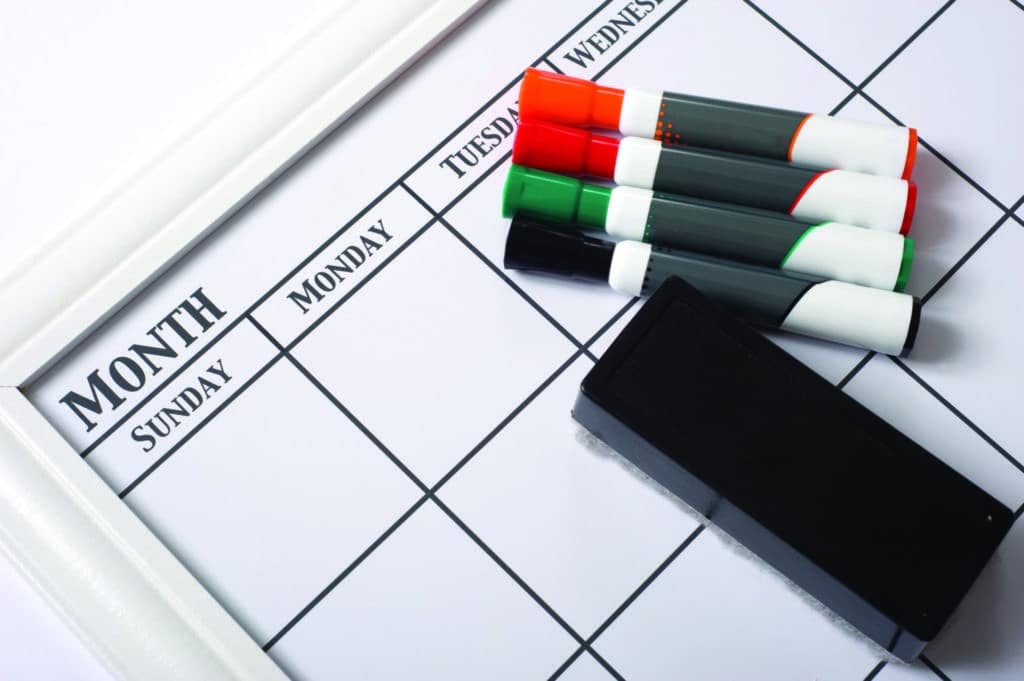Traditional dry-erase boards for home use are made of inexpensive melamine, and larger boards for office use are generally manufactured with expensive heavy glass or porcelain. As a result, dry-erase boards are generally only formed as rectangular flat boards or panels inserted into frames for use as doors, wall panels, and cubicle partitions. In addition, cheaper dry-erase coatings tend to suffer from “ghosting”—they do not erase completely and require cleaning using liquid cleansers that can rapidly wear down the coating. Universal Chemicals & Coatings (Unichem) has developed a new coating, Uni-rase, that is allowing the manufacture of dry-erase “boards” on curved surfaces and even as three-dimensional shapes.
“Porcelain- and glass-covered dry-erase surfaces cannot be formed, which limits their potential use in a wider array of office products,” says Dan Chin, president of Unichem, a custom adhesives and coating formulator. “Their weight also poses limits in the size, application, and mounting of dry-erase boards,” he adds.
The new dry-erase coating is formulated for coil-coating application onto aluminum and steel substrates, which can then be formed, bent, and/or cut to create dry-erase surfaces for use in homes, offices, appliances, and other products. Coil coating is a high-speed process in which a coating is applied to a variety of metal substrates such as aluminum, cold rolled steel, or hot dipped galvanized steel. The coated materials are then shipped for later fabrication and forming into parts or products. Unlike porcelain and glass, a coil-coated substrate with a special dry-erase coating can be precision slit, stamped, sheared, roll formed, and incorporated into a wide range of sizes or shapes, according to Chin.
“In addition to post-forming of the coated-coil substrates into whiteboards, which can be incorporated into wall panels, partitions, and office furniture installations, the flexibility of these coated materials allows for the formation of aesthetically curved or 3D surfaces that can be used by manufacturers, architects, and interior designers in entirely new applications,” Chin notes. Coil substrates weigh less than glass and porcelain, and thus the dry-erase “boards” produced with the new coil coating are much lighter, making installation simpler. Furniture containing them are also lighter and more easily moved and shipped.
As importantly, the Uni-rase coating has improved dry-erase properties, such as excellent ghosting resistance or shadowing typical of many current competitive products on the market. Unichem has tested their dry-erase coatings with more than 100 markers from different manufacturers, including permanent markers. “In the erasability tests, the coating has to show little to no ghosting as well as meet the durability (mark-erase cycles) testing,” says Chin. “It is also important to build in resistance to moisture because some common dry erase products tend to ghost severely in high humidity climates.” The coating survived over 10,000 cycles of erasability as well as heat and humidity cycling and passed stringent requirements for cleanability for all of the markers tested (the permanent markers were removed with spray cleaners).
Another unique characteristic of the Uni-rase coating is its ability to allow for sublimation printing of logos and branding, including photo quality images or other graphics. Dry-erase boards by their nature are designed to prevent ink from sticking, and as a result typically only the printing of simple graphics is possible. Uni-rase, however, is designed to accept photographic quality sublimation inks, making it possible to incorporate impactful, complex images that have the same dry-erase properties as the rest of the coated surface. “The coating is capable of high image clarity, and accurate ink transfer in the sublimation process results in photo-quality transferred images,” Chin says. As a result, dry-erase “board” manufacturers can customize white boards for specific use by including complex images for branding purposes—either their own or their customers’—without affecting the dry-erase performance of the product.
The sublimation process used to create the images essentially introduces heat to turn solid ink particles directly into a gas, which permanently colors the surface and sub-surface of the dry-erase board, preventing the ink from washing away, according to Chin. The use of the specially formulated dry-erase coating makes this process possible. Because the sublimation image is embedded into the coating, writing over the image with dry-erase markers is not a problem and will not have any negative effect on the quality of the sublimated image. “Now you can infuse (sublimate) permanent inks into the coating—such as for photos, logos, patterns, calendars, or industry-specific formats or graphics—yet retain dry-erase board erasability,” says Chin. “The image in the coating is every bit as good as the actual printed photo, so it enhances visual impact and aesthetics.”
The chemistry behind the Uni-rase coating is proprietary, but Chin does observe that it is the result of significant R&D time and effort devoted to development, testing, and verification. “This technology was a result of very intentional formulation of a system that would outperform competitive products,” he says.
Currently, the coating is available only as a coil coating, but it could be made available in a spray application if desired, according to Chin. The coating can also be adjusted for use in a number of different applications, such as post-painting. With respect to substrate preparation, he notes that the surface to be coated must be properly cleaned (free of oil and dirt) and dried before application.
Unichem works closely with the service centers that coordinate the metal and coating purchases, the coil coaters that apply its coatings, and the furniture OEMs that purchase coated substrates for incorporation into their products, according to Chin. “We have very good relationships with everyone in the supply chain; it takes a cooperative combined effort to service the OEMs,” he explains.
CoatingsTech | Vol. 15, No. 2 | February 2018
